How Heavy? How Light? - Exercise-wise Questions and Answers For Class 4 Maths - Free PDF Download
In Class 4 Maths Chapter 12 - "How Heavy? How Light?", we dive into the exciting world of weights! Get ready to explore and compare the heaviness and lightness of different things. We'll use scales, discover units like kilograms and grams, and have fun with practical activities. Let's make learning about weight super cool! Vedantu provides NCERT Solutions for Class 4 Maths Chapter 12 How Heavy? How Light? in the PDF format for free download by students. Every sum given in the exercise of the NCERT Class 4 Maths Chapter 12 is solved and explained in these NCERT Solutions in a detailed stepwise manner. By referring to these NCERT Solutions students can get a better understanding of the concept of weights. With the help of the NCERT Solutions for Class 4 Maths Chapter 12 How Heavy? How Light? students can prepare this chapter for their exams more effectively.
 Table of Content
Table of ContentClass: | |
Subject: | |
Chapter Name: | Chapter 12 - How Heavy? How Light? |
Content-Type: | Text, Videos, Images and PDF Format |
Academic Year: | 2025-26 |
Medium: | English and Hindi |
Available Materials: |
|
Other Materials |
|
NCERT Solutions for Class 4 Maths Chapter 12 How Heavy? How Light? teaches us the weight of the objects and how to weigh them. This is one of the most important concepts in Maths that children must learn at this budding stage.
We need to measure a lot of things in our day-to-day life. We measure distance, length, weight, time, and temperature. All the things we measure are counted with the help of a unit. A unit is the smallest quantity of something that we can measure.
Access NCERT Solutions for Class 4 Maths Chapter 12- How Heavy? How Light?
1. Father gave them some idea of the weight of each thing.
Thing loaded | Weight |
A sack of wheat | 100kg |
A sack of rice | 35kg |
Water tank | 50 kg |
Almirah | 70kg |
A table | 10kg |
A chair | 5kg |
A mattress | 20kg |
Bamboo ladder | 10kg |
Pots and pans | 10kg |
Find out the total weight they had loaded on the cart. Now they decided to remove a few things from the cart.
Which things should be removed so that the weight of the load is not more than 700 kgs?
Ans: The things loaded on the cart are and their weights are:
5 Sack of wheat = \[5 \times 100kg{\text{ }} = {\text{ }}500kg\]
3 sack of rice = \[3 \times 35kg = 105kg\]
1 water tank = \[1 \times 50kg = 50kg\]
1 Almirah = \[1 \times {\text{7}}0kg = 70kg\]
3 Tables = \[3 \times 10kg = 30kg\]
4 Chairs = \[4 \times 5kg = 20kg\]
2 Mattresses = \[2 \times 20kg = 40kg\]
1 Bamboo ladder = \[1 \times 10kg = 10kg\]
1 Pot and pan = \[1 \times 10kg = 10kg\]
The total weight of the things loaded is equal to the sum of the weights of the individual thing.
Therefore the total weight of the things loaded =\[500 + 105 + 10 + 50 + 70 + 30 + 20 + 40 + 10 + 10{\text{ }} = {\text{ }}845{\text{ }}kg\].
The total weight of things loaded = 845 kg.
\[845{\text{ }}kg--700{\text{ }}kg = 145{\text{ }}kg.\]
For the weight of the load is not more than 700 kg,
We need to remove 145 kg from the load.
A sack of wheat + A sack of rice + A table = \[100 + 35 + {\text{1}}0 = 145{\text{ }}kg\]
So we can remove a sack of wheat, rice, and a table from the load so that the weight of the load will not be more than 700 kg.
2. Now you also make your own balance. Write down how you made it. Also, draw a picture of your balance in the box below.
Ans:
Steps to make a balance:
Take a Symmetrical rod.
Now take two similar wires and tie it at both the end of the rod.
Take two similar pans and hang the plate with the help of the rod.
Now place the hook at the centre of the symmetrical rod.
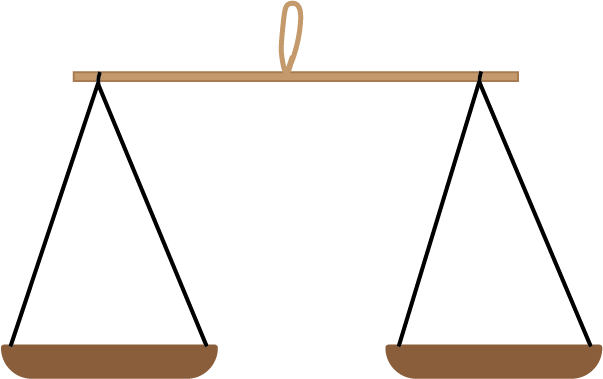
3. Activity Mannu and Jaiju put a pencil and a geometry box in the two pans of the balance. Which pan will go down? Why? Draw a picture to show it.
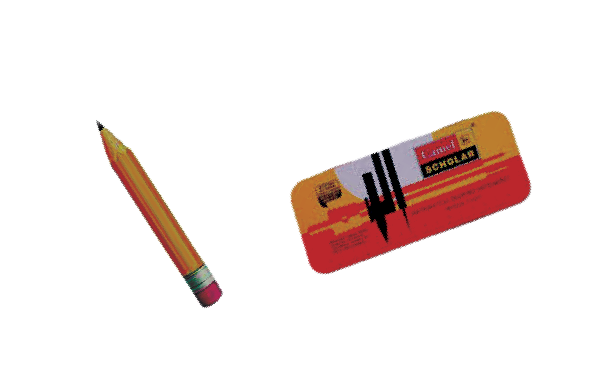
Ans: The pan which has a geometry box will go down because the geometry box is heavier than a pencil.
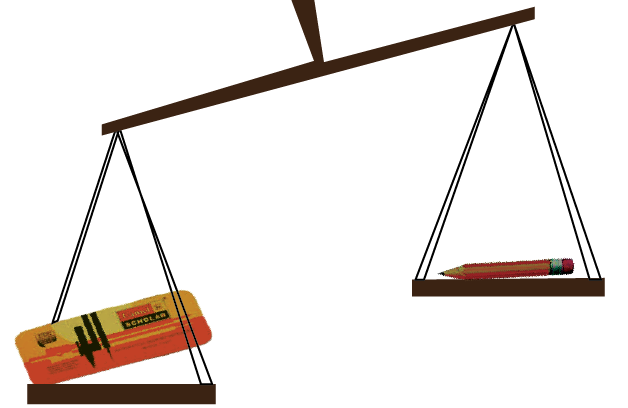
4. What is heavier? Make pairs of different things and use the balance to decide which is heavier. First guess which thing will take the pan down and then check with your balance.
Ans: Let us make a pair of geometry boxes and a pencil. As we know that a geometry box is always heavier than a pencil, it will take the pan down.
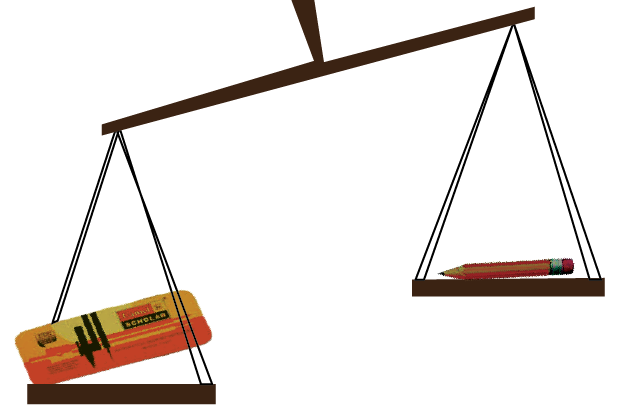
5. What is the heaviest? Make groups of three things. For example - eraser, ball and paper. Use the balance to arrange them in order of weight – the lightest, the one within–between weight, the heaviest. Complete the table with at least five examples.
Can you find your own weight using this balance?
Ans:
Lightest | In-Between weight | Heaviest |
Paper | Eraser | Ball |
Pencil | Pen | Box |
Paper | Notebook | Laptop |
Handkerchief | Scarf | Jeans pant |
Mouse | Keyboard | Cpu |
Groundnut | Lemon | Papaya |
Balance is invented to find which is heavier given two objects, so we cannot find our own weight using this balance.
6. Practice Time
Which pan of the balance will go down? Show by drawing an arrow.
Is the weight on any of the pans equal to 1 kilogram? Mark it.
6. (a)
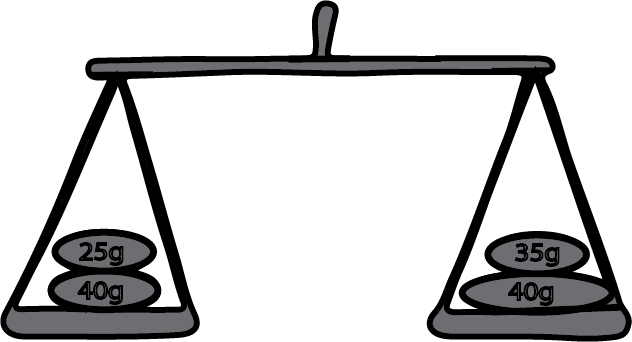
Ans: In the above diagram the left pan has 65g and the right pan has 75g, so the right pan will go down.
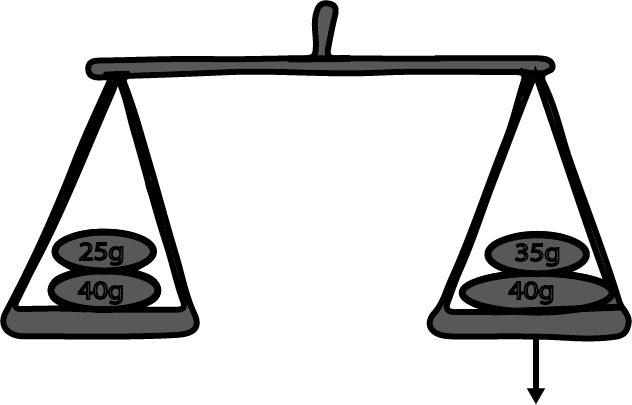
6. (b)
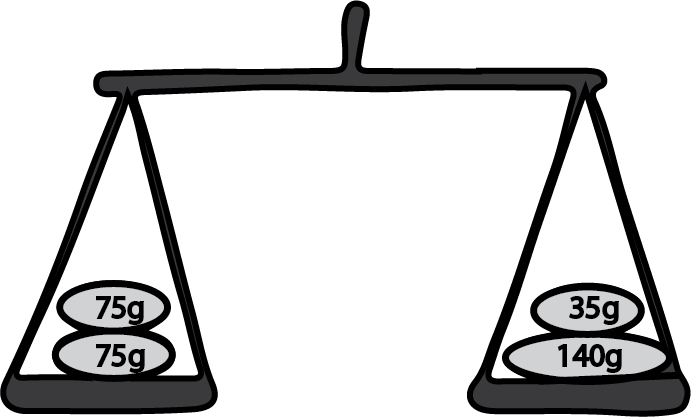
Ans: In the above diagram the left pan has 150g and the right pan has 175g so the right pan will go down.
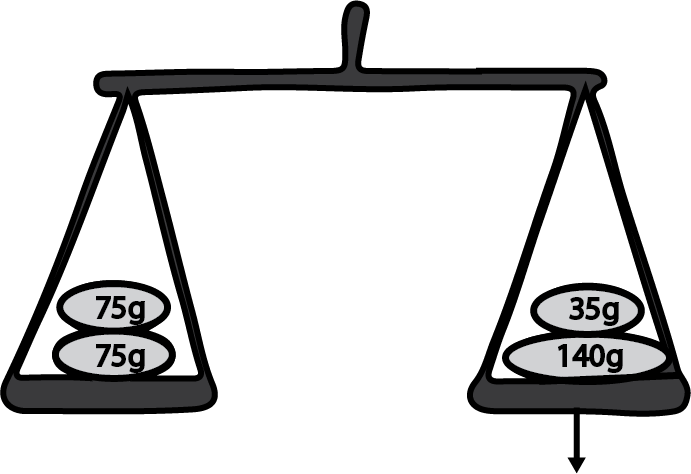
6. (C)
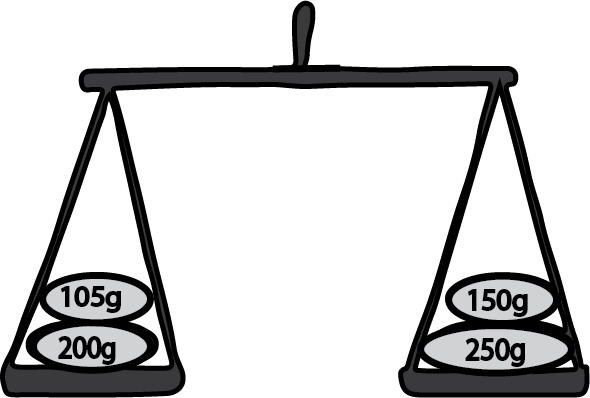
Ans: In the above diagram the left pan has 300g and the right pan has 400g, so the right pan will go down
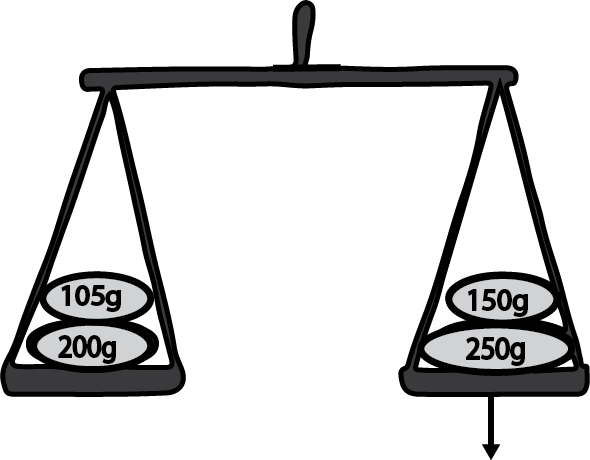
6. (d)
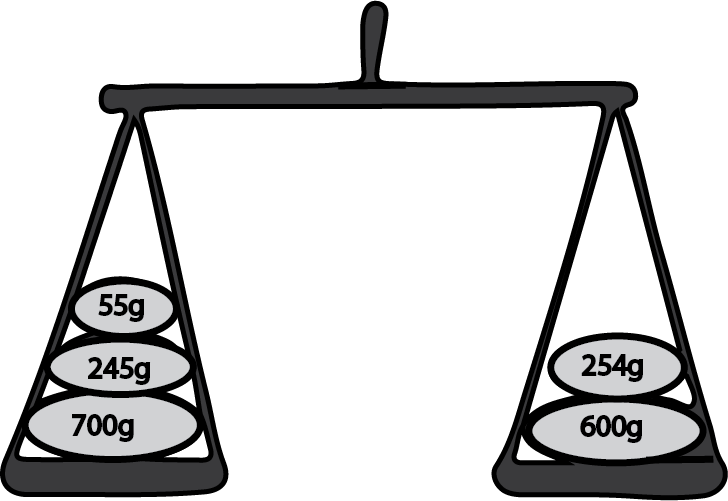
Ans: In the above diagram the left pan has 1000g and the right pan has 854g, so the left pan will go down.
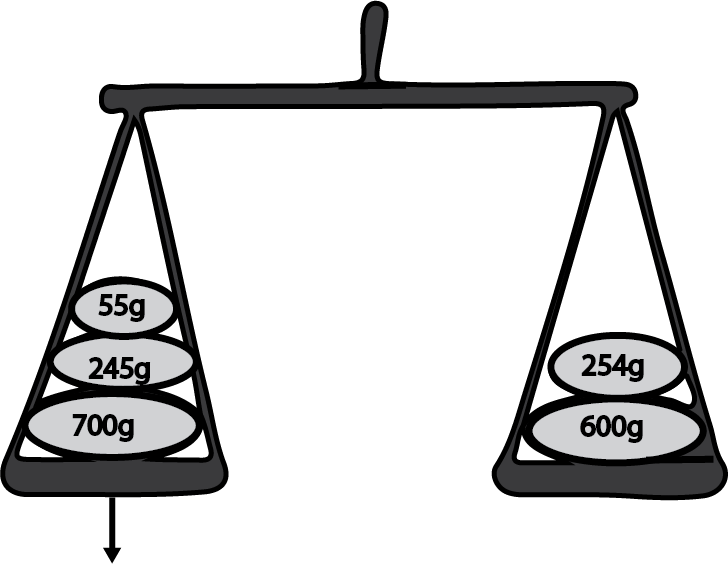
6. (e)
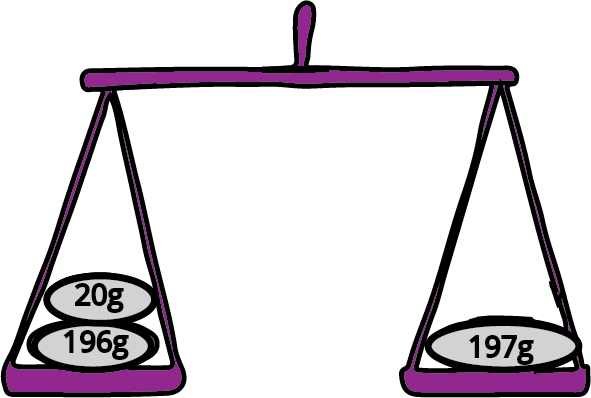
Ans: In the above figure the load in the left pan is higher than the load in the right pan, so the left pan will go down.
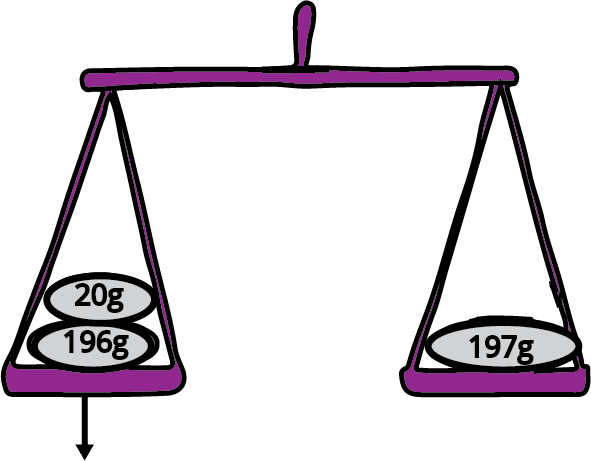
6. (f)
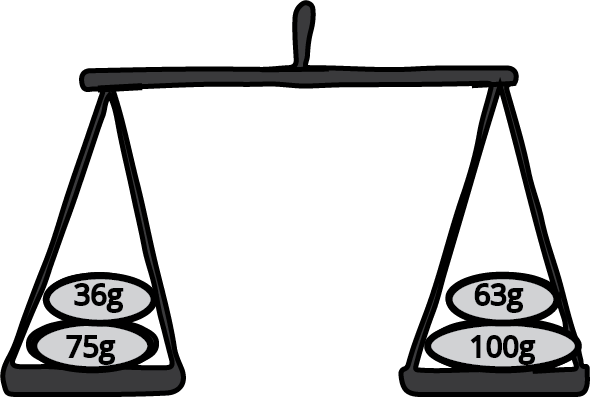
Ans: In the above diagram the right pan has heavier load than the right, so the right pan will go down.
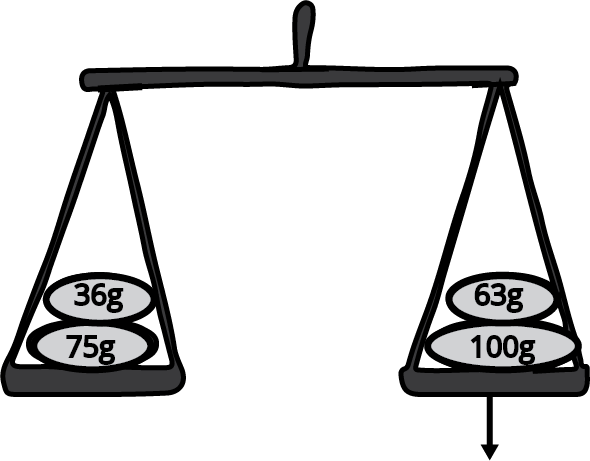
Yes, the 4th diagram has 1000g in the left pan which is equal to 1kg.
7. Grams and Kilograms Name 5 things that we usually buy.
In grams | In kilograms |
1. | 1. |
2. | 2. |
3. | 3. |
4. | 4. |
5. | 5. |
Ans: In grams we buy things which are required in very less quantity whereas in kg we buy things which are required in large quantities.
In grams | In kilograms |
1.Chilli powder | 1. Rice |
2. Soap | 2. Sugar |
3. Green chillies | 3. Carrots |
4. Turmeric powder | 4. Onions |
5. Cherries | 5. Pumpkin |
8. Guess and write the weight of each thing he bought in g or kg.
Items | Weight |
Rice | 5 |
Sugar | 1 |
Mustard seeds | 10 |
Wheat | 3 |
Dal | 500 |
Tea | 250 |
Pepper | 25 |
Ans: Rice, Sugar, Wheat are bought in kg because it weighs heavier and mustard seeds, dal, tea and pepper are bought in g.
Items | Weight |
Rice | 5kg |
Sugar | 1kg |
Mustard seeds | 10g |
Wheat | 3kg |
Dal | 500g |
Tea | 250g |
Pepper | 25g |
9. Now you show how Abdu will use these stone pieces to weigh.
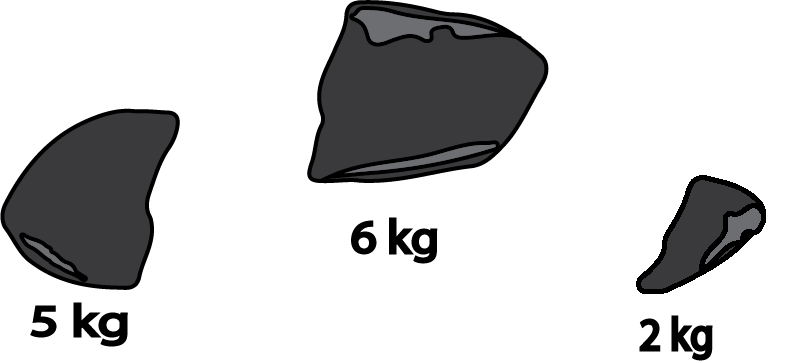
(a) 4 kg of firewood
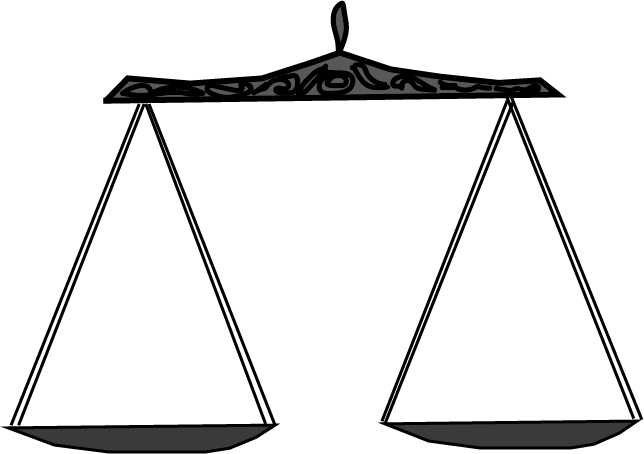
Ans: Abdu can place 6kg stone in one pan and 2kg stone along with firewood on another pan. Once the weights of both the pans are equal then he can say that the weight of the firewood is 4kg.
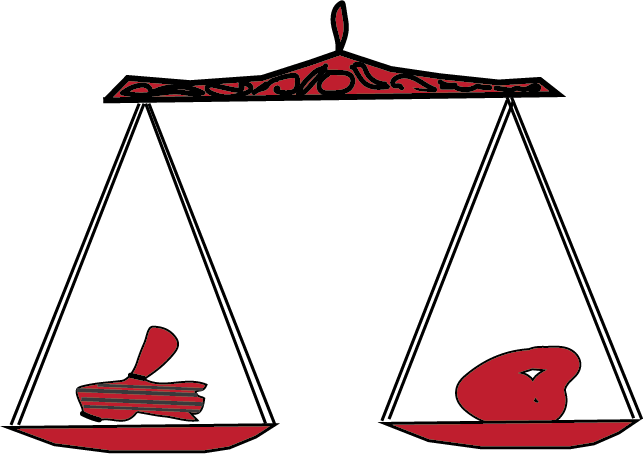
(b) 3 kg of firewood
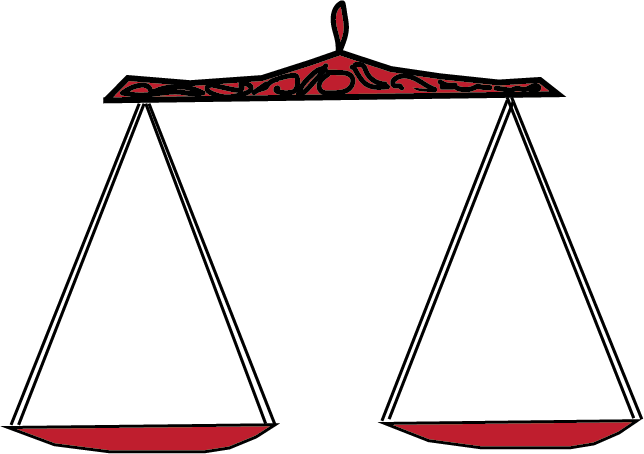
Ans: Abdu can place 5 kg stones on one pan and 2 kg of stone along with firewood on the other pan. If the weight of both the pan is equal he can say that the weight of firewood is 3kg.
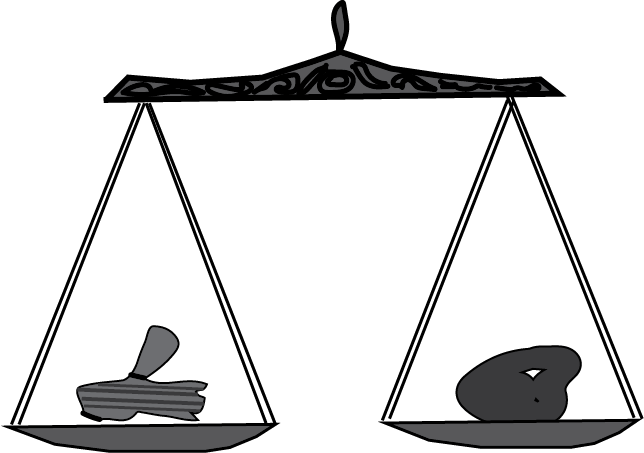
(c) 7 kg of firewood
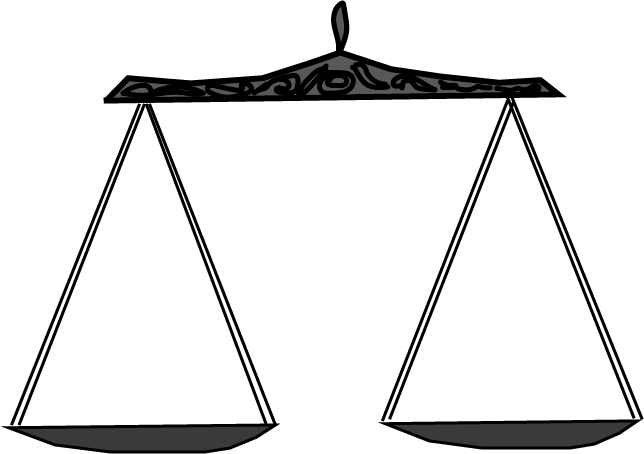
Ans: Abdu can place a 5kg and 2kg stone on one pan and firewood on the other pan. If both the pans become equal in weight, he can say that the firewood weighs 7kg.
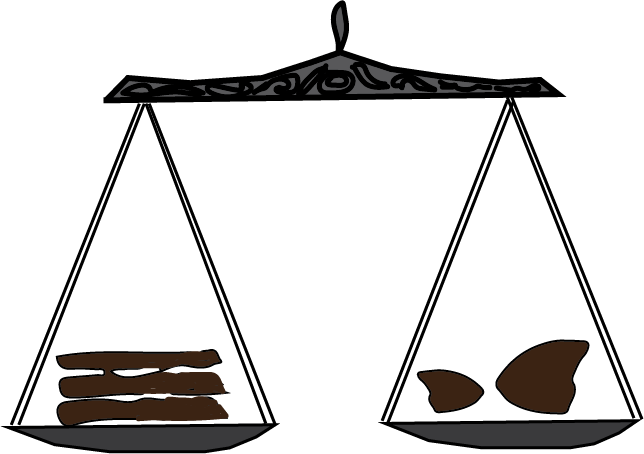
10. Post Office Have you ever been to a post office? __________ What different things do people go there for? How much does a postcard cost? __________ How much does an inland letter cost? __________
Ans: Yes, I have been to the post office twice with my Mother.
People go there to post and collect telegrams, letters etc.
A postcard usually costs one or two rupees.
An inland letter costs 3rs.
11.
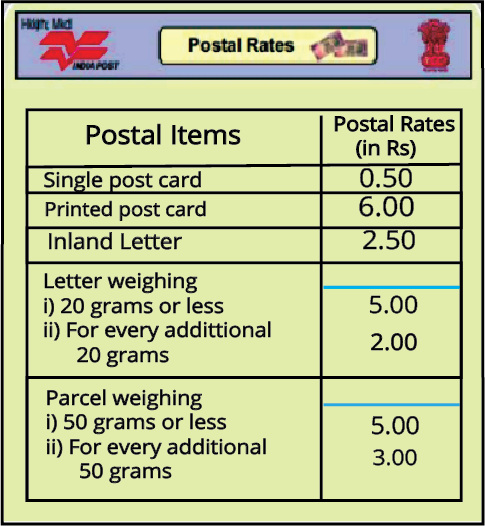
Look at the postal rates given in the chart.
11.1. How much will you have to pay for stamps on a letter weighing 50 grams? ___________
Ans: It is given that for 20 or less the postal rates are 5rs. And for every additional 20g the postal rate is 2rs.
\[50g = 20g + 20g + 10g\]
So, the stamp rate for the 50g letter = \[5 + 2 + 2 = 9rs\]
The total rate paid for the stamps = 9rs.
11.2.Akash wants to send a parcel of the Math Magic textbook to his friend Rani in Chennai. The book weighs 200 g. See the chart to find the cost of posting the book. __________
Ans: We know that the weight of the book is 200g.
\[200g = 50g + 50g + 50g + 50g\]
The cost for the parcel weighing less than or equal to 50g is 5rs and for every additional 50g the cost is 3rs.
Thus, the cost of the parcel = \[5rs + 3rs + 3rs + 3rs = 14rs\]
The cost for posting the book is 14rs.
12. Read the weight shown in the picture. Find out the cost of sending a parcel of that weight.
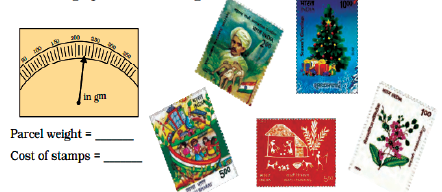
Parcel weight = _______ Cost of stamps = _______.
Ans: The total weight of the parcel is 230 g.
The cost of a 50 g parcel is Rs5 and for every extra 50g the cost is Rs3.
\[230g = 50g + 50g + 50g + 50g + 30g\]
Thus, the cost of the stamps = \[5rs + 3rs + 3rs + 3rs + 3rs{\text{ }} = 17rs\]
Thus the total cost of a parcel weighing 230g is 17rs.
Parcel weight = 230g Cost of stamps = 17Rs.
13. How Many Stamps?
Rahul needs stamps of Rupees 25 for his parcel. He went to the post office. Only stamps of Rs1, Rs2, Rs5, and Rs10 were there at that time. Using those stamps in how many different ways can he make Rs25?
Can you show five different ways? What is the heaviest parcel he can send using stamps of Rs25?
Ans: The 5 different ways are shown below:
(1) 5 stamps of \[5rs = 5rs \times 5rs = 25rs\]
(2) 1 stamp of 5rs and 2 stamps of \[10rs = 10rs + 10rs + 5rs = 25rs\]
(3) 10 stamps of 2rs each and 1 stamp of 5rs.
= \[2rs \times 10 = 20rs\]for 10 stamps and 5rs of one stamp =\[20rs + 5rs = 25rs\]
(4) 3 stamps of 5rs each and 5 stamps of 2rs
\[\;5rs \times 3 = 15rs\]for 3 stamps
\[\;2rs \times 5 = 10rs\]for 5 stamps
3 stamps of 5rs each and 5 stamps of \[2rs = 15rs + {\text{1}}0rs = 25rs\]
(5). 3 stamps of 5rs each and 1 stamp of Rs10
= \[5rs \times 3 = 15rs\]for 3 stamps
Total =\[15rs + 10rs = 25rs\].
14. Our Weight Together: A frog was struggling to escape from the mouth of a crow. How can I escape? The frog thought. Suddenly a trick came to his mind. He asked the crow Are you good at arithmetic? If yes, then I will ask you a problem.
Your weight is 650 g and I am only 145 g. How much do we weigh together?
The crow was good at mathematics, so he sappily opened his beak to answer. What happened after that? So what was the answer the crow wanted to give? ___________
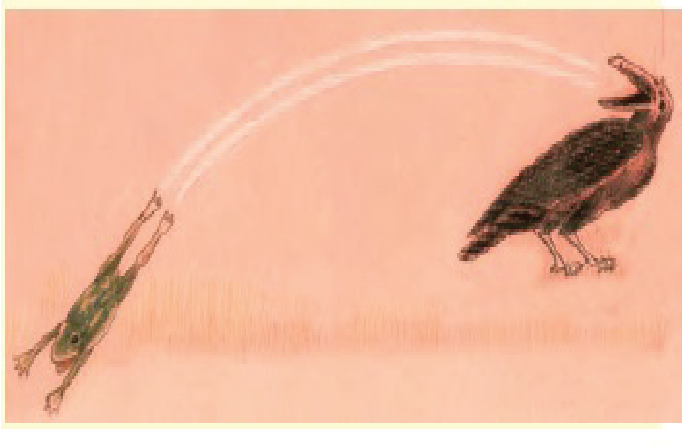
Ans:
The weight of the crow = 650 g
The weight of the frog = 145 g
The weight of the crow and the frog together = \[650g + 145g = 795g\]
The crow happily said the answer was 795g and when the crow opened the mouth the frog escaped from the crow’s mouth.
15. Now, you also fill the table by finding out the age, height and weight of any five friends.
Name | Age | Height | Weight |
Ans: Let us take five friends whose names are Anoop, Taufeeq, Harish, Sattheesh, Suresh.
Enter the age, height, and weight as you wish.
Name | Age | Height | Weight |
Anoop | 12 | 130cm | 40kg |
Taufeeq | 13 | 135cm | 43kg |
Harish | 10 | 159cm | 50kg |
Sattheesh | 11 | 141cm | 37kg |
Suresh | 15 | 159cm | 55kg |
16. How Many Oranges? All oranges have equal weight. The two papayas have the same weight. The weights in the first and second balances are equal. How many oranges balance the weight in the third?

Ans: In the first balance there is an orange and papaya in the left pan and 3 oranges in the right pan.
We can understand that
1 orange + 1 Mango = 3 orange
Removing 1 orange from both sides,
1 Mango = 2 orange
From the 2nd balance,
2 papaya = 2 oranges + 1 mango
We know that 1 mango = 2 orange
2 papaya = 4 orange
i.e. 1 papaya = 2 orange
From the 1st and 2nd balance,
1 mango = 2 orange
1 papaya = 2 orange
So,
1 mango = 1 papaya
In the 3rd balance, there is 1 mango and 1 papaya in the left pan
i.e. 1 mango + 1 papaya = 2 orange + 2 orange = 4 oranges
Thus, to balance the weight in the third image, 4 oranges need to be placed.
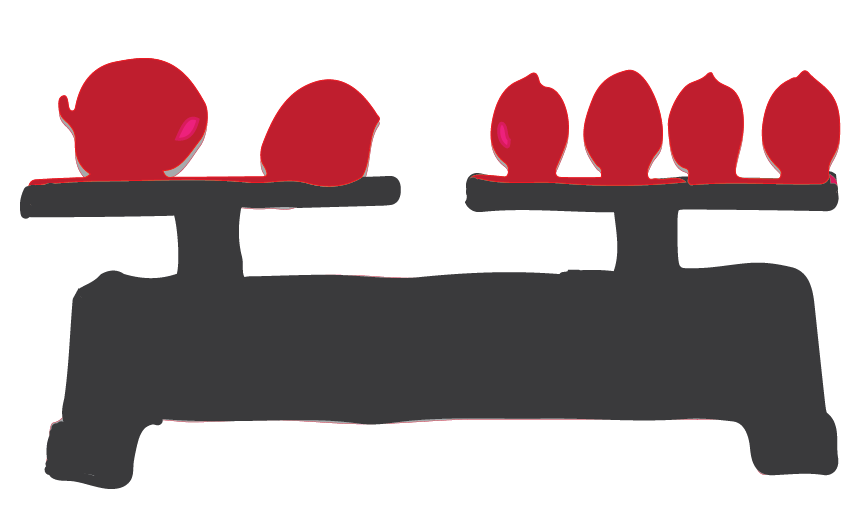
17. Find That Marble: There are 3 marbles of the same size but one marble is slightly heavier or lighter than the other two. Can you find which is that marble and if it is heavier or lighter? You can use a balance only two times.
Ans: If there are 2 marbles of the same weight and 1 marble slightly heavier or lighter than the other two then we can find out which marble is slightly different in the following ways:
Step 1: Name the marbles as x, y, z.
Step 2: Place x on one pan and y on the other.
Case 1: Both the marble weigh the same
Case 2: The marble x is heavier than marble y.
Case 3: The marble y is heavier than marble x.
Step 3 of Case 1: If both the marble weighs the same then that means marble x and y are of the same weight and the weight of marble z is different. To find if marble z is heavier or lighter remove marble x and place marble z. If marble z is heavier than x then the third marble is heavier and if it weighs lighter than the third marble is lighter.
Step 3 for case 2: In this case, marble z is either equal to marble x or marble y. To find out, remove marble x (heavier) and place marble z against marble y (lighter).
There can be two cases again
Case 1- Marble z can be equal to marble y. This means both marble y and z are of equal weight and marble x is heavier.
Case 2- Marble z can be heavier than marble y. This means marble z and marble x are the same and marble y is lighter than the other two.
Step 3 for case 3: In this case, the marble x and y can be renamed. The heavier marble can be renamed as x and the lighter can be renamed as y. Now, to find out the weight of marble z. Repeat step 3 for case 2.
NCERT Solutions for Class 4 Maths Chapter 12 How Heavy? How Light?
Use of Some Common Measurements that We See Around Us:
A vegetable vendor weighs vegetables that we buy.
A scrap dealer weighs the scrap before paying the amount for it.
A cloth merchant measures the length of the cloth piece that we want to buy.
We measure time regularly.
Doctors measure temperature when we are sick.
In this section, we will discuss the measurement of weight.
Weight or mass is the measure of how heavy or light a thing is. Different things have different weights. The weight of lighter things is measured in milligram or gram. They are written as mg and g respectively. Weight of heavier things is measured in kilograms and it is written as Kg. Weight is measured by using a weighing balance and electronic balance.
1000 milligrams = 1gram
1000 grams = 1 kilogram
Beam Balance
Beam balance is an instrument to measure the weight of something.
(Image will be Uploaded Soon)
(Image will be Uploaded Soon)
In the above image of the beam balance, the object that is to be measured should be kept in the right-hand side pan and standard weights should be kept on the left-hand side pan.
Standard Weights
(Image will be Uploaded Soon)
(Image will be Uploaded Soon)
These weights are kept on the left-hand side pan.
Conversion of Weight
To convert kilograms (kg) into g, put three 0s on the right.
Example: Convert 5 kg into grams
1 kg = 1000 gms
5 kg = 5 x 1000gms = 5000 gms
Let us do the opposite conversion, i.e. from grams into kilograms.
1000 gms = 1 kg
3000 gms = 3 kg
Chapter Summary - How Heavy, How Light
In Class 5 Maths Chapter 12 - "How Heavy, How Light," young learners explore the concepts of weight and measurement. The chapter introduces the idea of comparing the heaviness and lightness of different objects. Students engage in fun activities to understand the concept of weight, using scales and everyday items. Practical examples make learning enjoyable as they discover how to express weights in standard units. Through playful exercises and relatable scenarios, the chapter aims to build a solid foundation in understanding weights, helping Class 4 students develop essential mathematical skills in a simple and enjoyable manner.
Why Choose Vedantu’s NCERT Solution for Class 4 Maths?
Key Features of NCERT Solutions for "How Heavy, How Light" Class 5 Maths Chapter 12:
1. Easy Explanations: The solutions help you understand each exercise and question really well. It's like having a teacher explaining things to you!
2. Simple Presentation: Everything is organised neatly, making it easy to follow and learn. No confusing stuff!
3. Correct Answers: The solutions give you the right answers that match what you learn in class. That way, you can feel confident about what you know!
4. Helpful Pictures: There are pictures and drawings to make tricky ideas easy to understand. It's like having pictures to help tell the story of Maths!
5. Useful Tips: You get extra tips and tricks to do even better. It's like having secret strategies to be a Maths superhero!
6. Quick Summaries: There are short summaries to quickly remember what you learned. It's like a little reminder of all the cool stuff you discovered!
7. Online and Downloadable: You can use them online or download them. So, you can study wherever and whenever you want. It's like having your Maths helper always with you!
Conclusion
Now, with the knowledge gained about weighing things, Class 4 students can tackle the exercises at the end of the chapter. This skill is super important in our everyday tasks. As we've seen, measurements are a part of everything we do. Learning about weight in Chapter 12, "How Heavy, How Light," helps us understand heavy and light, use scales to compare, and discover units like kilograms and grams. Doing fun activities with real things and using pictures makes it all easy to understand. And don't forget the chapter summaries – they're like quick reminders of all the cool stuff we learned!
Other Study Material for CBSE Class 4 Maths Chapter 12
S.No. | Important Links for Class 4 Maths Chapter 12 |
1 | |
2 | Class 4 How Heavy? How Light? Important Questions |
Chapter-Specific NCERT Solutions for Class 4 Maths
S.No. | NCERT Solutions Class 4 Chapter-wise Maths PDF |
1 | |
2 | |
3 | |
4 | |
5 | |
6 | |
7 | |
8 | |
9 | |
10 | |
11 | |
12 | |
13 |
CBSE Class 4 Maths Study Materials
S.No. | Other Sudy Materials for Class 4 Maths |
1 | |
2 | |
3 | |
4 | |
5 | |
6 | CBSE Class 4 Maths Important Questions |


















